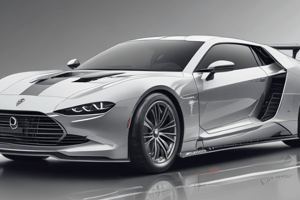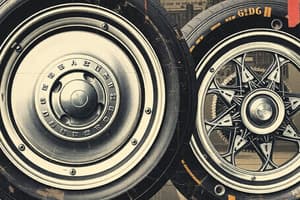Podcast
Questions and Answers
Which of the following wheel types use tires mounted to rims that mount to the wheel using lugs?
Which of the following wheel types use tires mounted to rims that mount to the wheel using lugs?
- Hub piloted
- Stud piloted
- Disc wheels
- Cast spoke wheels (correct)
If a set of dual tires were properly matched, which following would be true?
If a set of dual tires were properly matched, which following would be true?
- All the above (correct)
- Both tires would have the same tread size
- Both tires would have equal wear
- Both tires would have the same nominal size
Which of the following methods should be used to completely deflate a truck tire?
Which of the following methods should be used to completely deflate a truck tire?
- The Schrader valve pin should be depressed
- The split rim should be separated
- The Schrader valve core should be removed (correct)
- A hydraulic bead buster should be used
Which type of tire tread is recommended for use on steering axles for on-highway trucks?
Which type of tire tread is recommended for use on steering axles for on-highway trucks?
What should be done to match multi-piece rim components properly?
What should be done to match multi-piece rim components properly?
Tech A says that he seats radial tire beads by using a Cheetah rapid discharge air tank. Tech B says that he seats radial tire beads using a metal ring inflation aid. Who is correct?
Tech A says that he seats radial tire beads by using a Cheetah rapid discharge air tank. Tech B says that he seats radial tire beads using a metal ring inflation aid. Who is correct?
What is the maximum allowable wheel runout permitted on cast spoke wheels?
What is the maximum allowable wheel runout permitted on cast spoke wheels?
Where is the brake drum mounted on a cast spoke wheel assembly?
Where is the brake drum mounted on a cast spoke wheel assembly?
Which type of wheel assembly presents the least maintenance and alignment problems?
Which type of wheel assembly presents the least maintenance and alignment problems?
Which type of hub requires heating in an oven to remove the bearing cups?
Which type of hub requires heating in an oven to remove the bearing cups?
Oil-lubricated drive axle wheel bearings receive oil from?
Oil-lubricated drive axle wheel bearings receive oil from?
Which type of wheel seal fits tightly to both the hub and axle spindle and moves within itself?
Which type of wheel seal fits tightly to both the hub and axle spindle and moves within itself?
Which of the following methods is used to lock the bearing setting on an axle or spindle?
Which of the following methods is used to lock the bearing setting on an axle or spindle?
Which of the following is the preferred method of repairing a wheel seal leak that has glazed the brake shape linings?
Which of the following is the preferred method of repairing a wheel seal leak that has glazed the brake shape linings?
Tech A says that an advantage of disc wheels over cast spoke is that they produce fewer wheel alignment problems. Tech B says that in stud-piloted disc wheel systems, a loose inner nut can easily go undetected, eventually pounding out the ball seat. Who is correct?
Tech A says that an advantage of disc wheels over cast spoke is that they produce fewer wheel alignment problems. Tech B says that in stud-piloted disc wheel systems, a loose inner nut can easily go undetected, eventually pounding out the ball seat. Who is correct?
Which of the following is said to be an advantage of low-profile radial tires?
Which of the following is said to be an advantage of low-profile radial tires?
Tech A states that any tire that tests 50 percent or less of its specified pressure should be removed from the truck and checked out in a safety cage. Tech B uses a slip-on air chuck with a remote in-line valve and gauge to inflate tires to 80 percent of specified pressure on a TPIS equipped vehicle. Who is correct?
Tech A states that any tire that tests 50 percent or less of its specified pressure should be removed from the truck and checked out in a safety cage. Tech B uses a slip-on air chuck with a remote in-line valve and gauge to inflate tires to 80 percent of specified pressure on a TPIS equipped vehicle. Who is correct?
Tech A says wheel axial runout on a cast spoke wheel can be eliminated only by removing the wheel rims and breaking down the tires. Tech B adjusts cast spoke wheel radial runout by chalk-marking high points, then loosening the lug nuts on the chalk-marked side and tightening those 180 degrees opposite. Who is correct?
Tech A says wheel axial runout on a cast spoke wheel can be eliminated only by removing the wheel rims and breaking down the tires. Tech B adjusts cast spoke wheel radial runout by chalk-marking high points, then loosening the lug nuts on the chalk-marked side and tightening those 180 degrees opposite. Who is correct?
What's must be done to install a Conmet PreSet hub to an axle?
What's must be done to install a Conmet PreSet hub to an axle?
When using the TMC method of adjusting wheel bearings, end play must be within what range?
When using the TMC method of adjusting wheel bearings, end play must be within what range?
Tech A always inflates severely under-inflated tires in a safety cage. Tech B uses a clip-on air chuck with a remote in-line valve and gauge. Who is correct?
Tech A always inflates severely under-inflated tires in a safety cage. Tech B uses a clip-on air chuck with a remote in-line valve and gauge. Who is correct?
Flashcards are hidden until you start studying
Study Notes
Wheel Types and Components
- Cast spoke wheels utilize tires mounted to rims that connect to the wheel via lugs.
- Dual tires should match in nominal size, tread size, and wear for optimal performance.
- Complete deflation of a truck tire is achieved by removing the Schrader valve core.
- Rib tread patterns are recommended for steering axles in on-highway trucks.
Rim and Tire Maintenance
- To properly match multi-piece rim components, measure sizes, cross-check part numbers, and use components from the same OEM.
- Both Tech A (using a Cheetah rapid discharge air tank) and Tech B (using a metal ring inflation aid) are correct regarding radial tire bead seating.
- Maximum allowable wheel runout for cast spoke wheels is 1/8 inch.
- The brake drum is mounted on the inboard side of the wheel hub in cast spoke wheel assemblies.
Wheel Assembly Types
- Hub-piloted wheels present the least maintenance and alignment issues compared to other wheel types.
- Aluminum hubs require heating in an oven to remove bearing cups.
- Oil-lubricated drive axle wheel bearings receive oil primarily from the banjo housing.
Seals and Fastening Methods
- Unitized seals fit tightly to both the hub and axle spindle, moving within themselves.
- Various methods lock steering settings on axles or spindles, including jam nuts and castellated nuts with cotter pins.
- Preferred repairs for a wheel seal leak that glazed brake linings involve replacing the seal and brake shoes on both sides of the axle.
Tire Performance and Safety
- Both Tech A (on rim alignment issues) and Tech B (stud-piloted disc systems vulnerability) are correct regarding advantages of wheel types.
- Low-profile radial tires enhance traction, tread life, and vehicle stability.
- Any tire testing 50% or less of its specified pressure should be removed for safety checks in a safety cage.
Wheel Bearing Adjustments
- To eliminate wheel axial runout on cast spoke wheels, it’s necessary to break down the tires and remove the wheel rims.
- Adjustments for radial runout involve adjusting lug nuts based on the chalk-marked high points.
- Installation of a Conmet PreSet hub requires proper torque specification.
- The TMC method for adjusting wheel bearings dictates that end play must be maintained within the range of 0.001-0.005 inch.
Inflation Safety
- Tech A and Tech B are both correct in using safety cages and remote air chuck systems for inflating under-inflated tires.
Studying That Suits You
Use AI to generate personalized quizzes and flashcards to suit your learning preferences.




